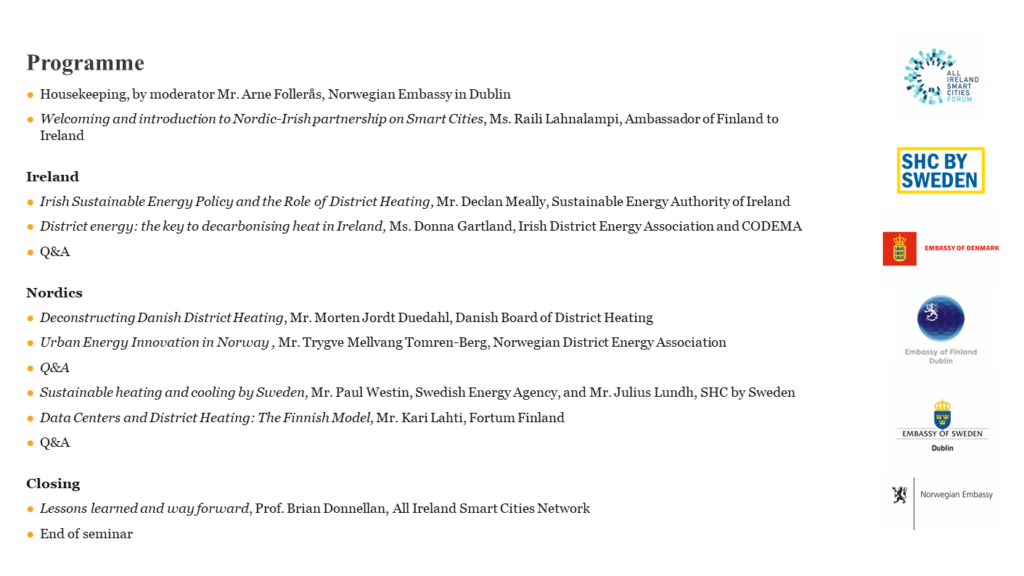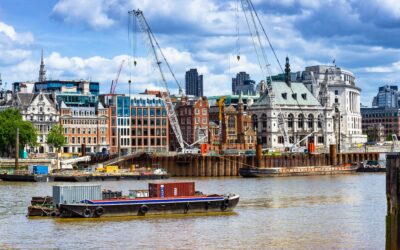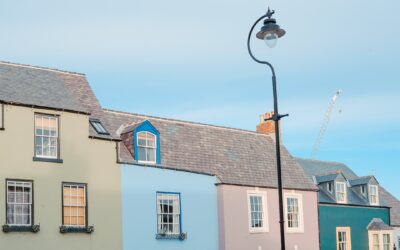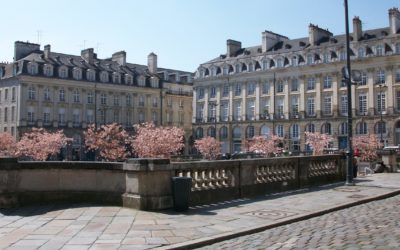The Nordic-Irish Partnership for Sustainable Cities recently organised a webinar on the topic of Innovative Sustainable Cities and District Heating, with a focus on energy transition and decarbonising heat across the Nordics and the island of Ireland. This article summarises the topics of the webinar, including the progress being made and the challenges that exist in the area of district heating and cooling in the Nordic region and Ireland. Key takeaways include the importance of national and local regulation for district heating as well as the promising opportunity of heat recovery in data centres.

Energy for heating constitute roughly 39% of Ireland’s total energy consumption and is supplied primarily through gas boilers. Replacing the entire heating system with renewable alternatives remains a huge challenge, but the decarbonisation can to a large extent be supported through the implementation and utilisation of district heating networks.
The Sustainable Energy Authority of Ireland (SEAI) have identified barriers that increases the challenge of widespread deployment of district heating networks in Ireland:
However, progress is being made on several fronts:
District heating supplies almost two thirds (64%) of all households and over half of the total heat demand in Denmark. In major cities like Copenhagen, the share of households supplied by district heating is as high as 98%. This is achieved with competitive prices, even slightly declining.
The Danish Board of District Heating (DBDH) attempted to deconstruct the success of district heating in the Denmark by taking the views of industry experts. An interesting takeaway was that while most considered technology an important aspect of achieving set goals and targets, it was not regarded as a decisive factor for the success of district heating. Instead, three factors were named by respondents as crucial; namely trust, clear coals and ownership.
Trust can be achieved through democratic ownership in the form of municipal utilities or co-ops where end users are also owners and can exercise control. Furthermore, trust depends on profit regulation, strong consumer protection and transparency. Clear goals need to be set for successful deployment of district heating, such as low heat prices, convenience, sustainability and reliability. Ownership should involve end users to ensure all stakeholders strive towards the same goals.
Current developments in Denmark focus on achieving efficiency in all areas, e.g. by utilising excess industrial heat. A prime example is the collaboration between Facebook and a Danish district heating company where excess heat from a data centre is used to heat Danish homes. Read more here >
In Norway, renewable sources account for 98% of electricity. Simultaneously, the effort of electrifying vehicles has come a long way with more than half of the fleet now electric. This puts a lot of pressure on the power grid, which is currently one of the big challenges to overcome.
In terms of heat, focus is on waste-to-energy and energy storage units. Excess heat coming out of waste is key for larger cities and covers more than half the demand. A lot of exploration in the area of thermal energy storage is being conducted, as well as the possibility of seasonal storage. Another area which is being explored is integrating large scale production with district heating systems to utilise the heat loss from electrolysis processes as a resource in the circular energy system. A large Nordic data centre development company, Digiplex, is integrating district heating in their strategy – both in Stockholm and in Oslo. See more here >
The Norwegian fjords already boast a famous beauty, and in the area of cooling there are now several cities using fjord water to cool buildings connected to district cooling networks. One example of this is Bergen, which you can see in the video here >
Sweden has achieved 65% renewables for heating and cooling, and 30% for transportation. Over half of Swedish heat is supplied by district heating, and an additional 25% comes from heat pumps. The main sources for heat supply in Sweden are biomass, energy-from-waste and ambient and excess heat. The use of fossil fuels for heating purposes is close to 0%. While these achievements are very positive, ambitious targets lie ahead.
Some of the key targets in Sweden’s energy policy include:
A promising opportunity to support the targets further is heat recovery in data centres. Stockholm Data Parks (SDP) is an initiative by the City of Stockholm, district heating and cooling provider Stockholm Exergi, power grid operator Ellevio and dark fiber provider Stokab. The initiative originates from a scheme started by Open District Heating in 2014, where companies were approached and asked if they wanted to sell excess or wasted heat.
To achieve heat recovery, SDP provides infrastructure elements at greenfield sites suited for data centre development. The data centre’s servers generate heat, which is captured by heat recovery technology. The heat is then distributed by the existing 2,800km network of district heating pipes underneath Stockholm. This benefits all stakeholders:
This business model can contribute to the heating of tens of thousands of homes while simultaneously making Stockholm an attractive hub for data centre development.
As mentioned above, a district heating pilot project is being conducted in the Tallaght area of South Dublin. Fortum is responsible for design, build, operation and maintenance of the district heating network. In the first phase, five buildings will be connected to the network, including the County Hall offices and the main campus building of the Technical University of Dublin Tallaght.
The district heating network in numbers:
Fortum has vast experience from district heating in Finland and beyond, and identifies four key factors contributing to the successful deployment and operation of district heating networks in Finland:
There are many interesting developments taking place in the area of district heating and cooling in the Nordic and Irish markets. Further collaboration and exchange of knowledge and experience can greatly contribute to overcoming barriers and challenges that exist in respective countries while supporting their ambitions to achieve a more sustainable energy system. The Nordic-Irish webinars provide a platform where the exchange of experiences and knowledge can take place, with the aim of sparking concrete initiatives and collaborative efforts in the district heating industry.
All presentations can be found and downloaded to the right -> and we also encourage you to follow the Nordic-Irish Partnership LinkedIn page > and visit the Partnership’s webpage hosted by the All Ireland Smart Cities Forum >
Speakers at the webinar included:

To stay updated on news for sustainable heating and cooling, follow us on Twitter and LinkedIn, and subscribe to our Newsletter.
Sweden is at the forefront of decentralised heat networks technology. Our aim for “Sustainable Heating & Cooling by Sweden” is to facilitate knowledge sharing between British, French and Swedish stakeholders and develop and encourage environmental and economic best practice.
To find out how we can help you and your organisation, please contact our London or Paris-based “SHC” teams. We can introduce you to leading consultants, suppliers of technology and services who will be pleased to share know-how of the development of sustainable heating & cooling solutions.


